TOPEKA, Kan. — Three days after the plan was first unveiled, the Kansas Senate approved a congressional redistricting map Friday.
The chamber moved at an unusually swift pace this week, introducing three options Tuesday, holding hearings and moving a map out of committee Thursday and taking a final vote Friday.
Every 10 years state lawmakers must redraw state and congressional lines to adjust to decennial census numbers.
Under the lines approved Friday by the Republican-dominated chamber, Kansas’ 3rd Congressional District — which encompasses the Kansas City metropolitan area and is represented by Democratic Rep. Sharice Davids — stretches south through Miami, Franklin and Anderson counties. The map splits Wyandotte County along Interstate 70, shifting the north half to the 2nd District, represented by Republican Jake LaTurner, and moving Lawrence, a left-leaning college town, to the vast 1st District, which takes in western and central Kansas.
The map was approved on a 26-9 vote, just shy of the supermajority needed to override a gubernatorial veto. Two Republican members were absent, however, making it likely that the votes for an override will be available if needed.
In a tense four-hour debate, Democrats accused Kansas Republicans of an intentionally rushed and opaque process in an effort to hamper David’s chances for reelection. Sen. Jeff Pittman, a Leavenworth Democrat, said the map had been “shotgunned” through the Legislature by a largely Wichita-based group of Republican leaders.
“This process has never been clear, it’s never been about listening to Kansans, it’s never been about keeping our communities together,” Senate Minority Leader Dinah Sykes, a Lenexa Democrat said. “The majority party has used selective listening to justify a map that makes no sense for Kansas, unless you see congressional districts as a means to one-party control.”
Republicans who drew the map, however, said their hope was to keep the entirety of Johnson County in one district. Mathematically, a combination of Johnson and Wyandotte counties would exceed the federally mandated district population by 44,000.
Johnson County has never been divided in congressional maps, prompting Republican lawmakers to leave it whole and combine it with counties to the south that are expected to grow in the next decade.
“The minority party is trying to create a new core for that district which historically has been Johnson County,” Senate President Ty Masterson, an Andover Republican, said. He dismissed criticisms of the process and the fairness of the map as political “red herrings.”
Sen. Molly Baumgardner, a Louisburg Republican, said Miami County residents in the 3rd District felt ignored by Davids and were pleased to see a proposal placing the entirety of Miami county in one district.
Davids is the only Democrat, woman of color or LGBTQ member of Kansas’ four-district congressional delegation. Businesswoman Amanda Adkins, who she beat by 10 points in 2020, is running against her again in 2022.
Under the new map Davids’ district would be an even split between Republicans and Democrats, according to data on Dave’s Redistricting. It creates a potentially a tough race in an election year where Republicans are favored to take control of the House of Representatives.
“This certainly is not as good for Sharice Davids as the district is now,” said Patrick Miller, a University of Kansas political scientist. “It’s certainly better than it could be and it creates a district that is, right now, better (for Davids) than the 3rd was 10 years ago.”
The map, which will reduce voting power of minority voters in Wyandotte County, has been vigorously opposed by Wyandotte officials and activists. The decision to split Kansas’ one majority-minority county in half is likely to result in legal challenges.
For decades, the county was divided between two congressional districts until a judge ordered it reunited in 1982. The proposed line would split the predominantly Hispanic communities south of I-70 from the predominantly Black communities to the north.
“Even with some of the racial or ethnic differences on where communities may be, it’s one vote. And whatever it is kind of dividing us and making us different, we also have unified interests in making sure that our community is well represented in the House of Representatives,” Andrew Davis, a Wyandotte County Commissioner told The Kansas City Star on Thursday.
State Sen. Dennis Pyle, a Hiawatha Republican, was the lone Republican opposing the map. He criticized party leadership for politicizing the process and failing to draw fair lines.
“It ought to make every one of us uncomfortable that if we can’t get together and come up with a map with 21 votes we’re going to end up with problems,” Pyle said.
The map still needs approval in the House and a signature from Gov. Laura Kelly. House lawmakers held a hearing on six potential maps Friday. Masterson said he moved the Senate as quickly as he did, in part, because he anticipates a gubernatorial veto.
Speaking to reporters, Kelly, a Democrat, wouldn’t say if she’d veto the map but reiterated previous statements advocating for keeping the Kansas City metropolitan area together.
“I stand by my firm belief that when you’re doing redistricting what’s important is to keep together communities of interest and ensure that you do disenfranchise a box of voters,” Kelly said.
House testimony mirrored concerns expressed to the Senate on Thursday that the so-called “ad astra” map would be “deeply unrepresentative” of the populations in Wyandotte and Douglas counties.
“(Wyandotte County) faces significant challenges including blight, economic disinvestment and lack of safe, quality and affordable housing,” said Rob Santel, a social worker in Wyandotte County, during the hearing. “Any attempt to divide Wyandotte County is an attempt to manipulate the map and further disenfranchise the voices of those most underrepresented.”
Two new maps were introduced by Democratic representatives in the House hearing, both of which keep the 3rd District relatively intact.
Reps. Jason Probst and Barbara Ballard, Hutchinson and Lawrence Democrats respectively, introduced a map that maintained Wyandotte County in Kansas’ 3rd Congressional District and expanded the 4th Congressional District to the Colorado state line.
State Rep. Vic Miller, a Topeka Democrat, introduced a map with very few changes to the current congressional district boundaries.
———
(The Star’s Aaron Torres contributed to this report.)
———







